Time-Efficient Allocation Mechanisms for Crowdsensing Tasks with Precedence Constraints †
Abstract
1. Introduction
- An efficient task allocation algorithm for tasks with precedence constraints is designed. As far as we know, this is the first work which considers the precedence constraints of tasks and the proposed algorithm can minimize the total execution time of all the tasks.
- A case study is given to show how to fit the proposed mechanism in the UAV system, by considering the features of UAV task allocation problem.
- Extensive simulations are conducted to evaluate the performance of the proposed algorithm, and the results show that the proposed algorithm has good approximate optimal ratios under different parameter settings.
2. Preliminaries
2.1. System Model
2.2. Problem Formulation
2.3. Analysis of the NP-Hardness
3. Algorithm Design
3.1. Task Level Division
| Algorithm 1 task level division |
| Require: the task set Ensure:
|
3.2. Final Task Set Construction
| Algorithm 2 Final task set construction |
| Require: the task set Ensure: the final task set 1: Set ; 2: for each task do 3: for each task do 4: for each task do 5: if then 6: Delete task from the final task set ; 7: return the final task set ; |
3.3. Allocation Priority Sequence Construction
| Algorithm 3 Allocation priority sequence construction |
| Require: the task set , the final task set , the refresh task sequence ; Ensure: the allocation priority sequence ;
|
3.4. Task Allocation
4. A Case Study: Task Allocation Mechanism for UAV System
5. Simulation
5.1. Simulation Setting
5.2. Simulation Results
6. Conclusions
Author Contributions
Funding
Conflicts of Interest
References
- Qiu, T.; Chen, N.; Li, K.; Atiquzzaman, M.; Zhao, W. How can heterogeneous Internet of Things build our future: A survey. IEEE Commun. Surv. Tutor. 2018, 20, 2011–2027. [Google Scholar] [CrossRef]
- Qiu, T.; Liu, X.; Li, K.; Hu, Q.; Sangaiah, A.K.; Chen, N. Community-aware data propagation with small world feature for internet of vehicles. IEEE Commun. Mag. 2018, 56, 86–91. [Google Scholar] [CrossRef]
- Qiu, T.; Zheng, K.; Han, M.; Chen, C.P.; Xu, M. A data-emergency-aware scheduling scheme for Internet of Things in smart cities. IEEE Trans. Ind. Inform. 2018, 14, 2042–2051. [Google Scholar] [CrossRef]
- Ganti, R.K.; Ye, F.; Lei, H. Mobile crowdsensing: Current state and future challenges. IEEE Commun. Mag. 2011, 49, 32–39. [Google Scholar] [CrossRef]
- Liu, J.; Shen, H.; Narman, H.S.; Chung, W.; Lin, Z. A Survey of Mobile Crowdsensing Techniques: A Critical Component for The Internet of Things. ACM Trans. Cyber-Phys. Syst. 2018, 2, 18. [Google Scholar] [CrossRef]
- Leonardi, C.; Cappellotto, A.; Caraviello, M.; Lepri, B.; Antonelli, F. SecondNose: An Air Quality Mobile Crowdsensing System. In Proceedings of the 8th Nordic Conference on Human-Computer Interaction: Fun, Fast, Foundational, Helsinki, Finland, 26–30 October 2014; pp. 1051–1054. [Google Scholar]
- Xu, C.; Li, S.; Zhang, Y.; Miluzzo, E.; Chen, Y. Crowdsensing the speaker count in the wild: Implications and applications. IEEE Commun. Mag. 2014, 52, 92–99. [Google Scholar] [CrossRef]
- Wan, J.; Liu, J.; Shao, Z.; Vasilakos, A.; Imran, M.; Zhou, K. Mobile crowd sensing for traffic prediction in internet of vehicles. Sensors 2016, 16, 88. [Google Scholar] [CrossRef]
- Pan, B.; Zheng, Y.; Wilkie, D.; Shahabi, C. Crowd Sensing of Traffic Anomalies Based on Human Mobility and Social Media. In Proceedings of the ACM SIGSPATIAL International Conference on Advances in Geographic Information Systems, Orlando, FL, USA, 5–8 November 2013; pp. 344–353. [Google Scholar]
- Foremski, P.; Gorawski, M.; Grochla, K.; Polys, K. Energy-Efficient Crowdsensing of Human Mobility and Signal Levels in Cellular Networks. Sensors 2015, 15, 22060–22088. [Google Scholar] [CrossRef] [PubMed]
- Rogstadius, J.; Vukovic, M.; Teixeira, C.A.; Kostakos, V.; Karapanos, E.; Laredo, J.A. CrisisTracker: Crowdsourced social media curation for disaster awareness. IBM J. Res. Dev. 2013, 57, 4:1–4:13. [Google Scholar] [CrossRef]
- Adeel, U.; Yang, S.; McCann, J.A. Self-Optimizing Citizen-Centric Mobile Urban Sensing Systems. In Proceedings of the International Conference on Autonomic Computing, Philadelphia, PA, USA, 18–20 June 2014; USENIX Association: Berkeley, CA, USA, 2014; pp. 161–167. [Google Scholar]
- Kumar, S.; Gil, S.; Katabi, D.; Rus, D. Accurate Indoor Localization with Zero Start-up Cost. In Proceedings of the Annual International Conference on Mobile Computing and Networking, Maui, HI, USA, 7–11 September 2014; pp. 483–494. [Google Scholar]
- Yuan, N.J.; Zheng, Y.; Zhang, L.; Xie, X. T-Finder: A Recommender System for Finding Passengers and Vacant Taxis. IEEE Trans. Knowl. Data Eng. 2013, 25, 2390–2403. [Google Scholar] [CrossRef]
- Zheng, Y.; Liu, F.; Hsieh, H.P. U-Air: When Urban Air Quality Inference Meets Big Data. In Proceedings of the ACM SIGKDD, Chicago, IL, USA, 11–14 August 2013; pp. 1436–1444. [Google Scholar]
- Zheng, Y.; Xie, X. Learning Travel Recommendations from User-generated GPS Traces. ACM Trans. Intell. Syst. Technol. 2011, 2, 2:1–2:29. [Google Scholar] [CrossRef]
- Du, Y.; Sun, Y.E.; Huang, H.; Huang, L.; Xu, H.; Bao, Y.; Guo, H. Bayesian Co-Clustering Truth Discovery for Mobile Crowd Sensing Systems. IEEE Trans. Ind. Inform. 2019. [Google Scholar] [CrossRef]
- Rana, R.K.; Chou, C.T.; Kanhere, S.S.; Bulusu, N.; Hu, W. Ear-phone: An End-to-end Participatory Urban Noise Mapping System. In Proceedings of the ACM/IEEE IPSN, Stockholm, Sweden, 12–16 April 2010; pp. 105–116. [Google Scholar]
- Reddy, S.; Estrin, D.; Srivastava, M. Recruitment Framework for Participatory Sensing Data Collections. In Pervasive Computing; Springer: Berlin/Heidelberg, Germany, 2010; pp. 138–155. [Google Scholar]
- Jaimes, L.G.; Vergara-Laurens, I.; Labrador, M.A. A location-based incentive mechanism for participatory sensing systems with budget constraints. In Proceedings of the IEEE PerCom, Lugano, Switzerland, 19–23 March 2012; pp. 103–108. [Google Scholar]
- He, S.; Shin, D.; Zhang, J.; Chen, J. Toward optimal allocation of location dependent tasks in crowdsensing. In Proceedings of the IEEE INFOCOM, Toronto, ON, Canada, 27 April–2 May 2014; pp. 745–753. [Google Scholar]
- Li, H.; Li, T.; Wang, Y. Dynamic Participant Recruitment of Mobile Crowd Sensing for Heterogeneous Sensing Tasks. In Proceedings of the IEEE MASS, Dallas, TX, USA, 19–22 October 2015; pp. 136–144. [Google Scholar]
- Boutsis, I.; Kalogeraki, V. On Task Assignment for Real-Time Reliable Crowdsourcing. In Proceedings of the IEEE ICDCS, Madrid, Spain, 30 June–3 July 2014; pp. 1–10. [Google Scholar]
- Goel, G.; Nikzad, A.; Singla, A. Mechanism design for crowdsourcing markets with heterogeneous tasks. In Proceedings of the AAAI HCOMP, Pittsburgh, PA, USA, 2–4 November 2014; pp. 77–86. [Google Scholar]
- Jin, H.; Su, L.; Chen, D.; Nahrstedt, K.; Xu, J. Quality of Information Aware Incentive Mechanisms for Mobile Crowd Sensing Systems. In Proceedings of the ACM MobiHoc, Hangzhou, China, 22–25 June 2015; pp. 167–176. [Google Scholar]
- Feng, Z.; Zhu, Y.; Zhang, Q.; Ni, L.M.; Vasilakos, A.V. TRAC: Truthful auction for location-aware collaborative sensing in mobile crowdsourcing. In Proceedings of the IEEE INFOCOM, Toronto, ON, Canada, 27 April–2 May 2014; pp. 1231–1239. [Google Scholar]
- Sun, J. An incentive scheme based on heterogeneous belief values for crowd sensing in mobile social networks. In Proceedings of the IEEE GLOBECOM, Atlanta, GA, USA, 9–13 December 2013; pp. 1717–1722. [Google Scholar]
- Ahmed, A.; Yasumoto, K.; Yamauchi, Y.; Ito, M. Distance and time based node selection for probabilistic coverage in People-Centric Sensing. In Proceedings of the IEEE SECON, Salt Lake City, UT, USA, 27–30 June 2011; pp. 134–142. [Google Scholar]
- Zhou, Z.; Feng, J.; Gu, B.; Ai, B.; Mumtaz, S.; Rodriguez, J.; Guizani, M. When Mobile Crowd Sensing Meets UAV: Energy-Efficient Task Assignment and Route Planning. IEEE Trans. Commun. 2018, 66, 5526–5538. [Google Scholar] [CrossRef]
- Liu, Y.; Guo, B.; Wang, Y.; Wu, W.; Yu, Z.; Zhang, D. TaskMe: Multi-task Allocation in Mobile Crowd Sensing. In Proceedings of the ACM UbiComp, Heidelberg, Germany, 12–16 September 2016; pp. 403–414. [Google Scholar]
- Gong, W.; Zhang, B.; Li, C. Location-Based Online Task Scheduling in Mobile Crowdsensing. In Proceedings of the IEEE GLOBECOM, Singapore, 4–8 December 2017; pp. 1–6. [Google Scholar]
- Iijima, N.; Sugiyama, A.; Hayano, M.; Sugawara, T. Adaptive Task Allocation Based on Social Utility and Individual Preference in Distributed Environments. Procedia Comput. Sci. 2017, 112, 91–98. [Google Scholar] [CrossRef]
- Eun, Y.; Bang, H. Cooperative task assignment and path planning of multiple UAVs using genetic algorithm. In Proceedings of the AIAA Infotech at Aerospace 2007 Conference and Exhibit, Rohnert Park, CA, USA, 7–10 May 2007; p. 2982. [Google Scholar]
- Boskovic, J.D.; Prasanth, R.; Mehra, R.K. A multi-layer autonomous intelligent control architecture for unmanned aerial vehicles. J. Aerosp. Comput. Inf. Commun. 2004, 1, 605–628. [Google Scholar] [CrossRef]
- Schumacher, C.; Chandler, P.; Pachter, M.; Pachter, L. Constrained Optimization for UAV Task Assignment. In Proceedings of the AIAA Guidance, Navigation, and Control Conference and Exhibit, Providence, RI, USA, 16–19 August 2004; p. 5352. [Google Scholar]
- Bellingham, J.; Tillerson, M.; Richards, A.; How, J.P. Multi-Task Allocation and Path Planning for Cooperating UAVs. In Cooperative Control: Models, Applications and Algorithms; Springer: Berlin/Heidelberg, Germany, 2003; pp. 23–41. [Google Scholar]
- Leary, S.; Deittert, M.; Bookless, J. Constrained UAV mission planning: A comparison of approaches. In Proceedings of the IEEE ICCV Workshops, Barcelona, Spain, 6–13 November 2011; pp. 2002–2009. [Google Scholar]
- Roberge, V.; Tarbouchi, M.; Labonté, G. Comparison of Parallel Genetic Algorithm and Particle Swarm Optimization for Real-Time UAV Path Planning. IEEE Trans. Ind. Inform. 2013, 9, 132–141. [Google Scholar] [CrossRef]
- Chatterjee, A.; Borokhovich, M.; Varshney, L.R.; Vishwanath, S. Efficient and flexible crowdsourcing of specialized tasks with precedence constraints. In Proceedings of the IEEE INFOCOM, San Francisco, CA, USA, 10–15 April 2016; pp. 1–9. [Google Scholar]
- Casbeer, D.W.; Holsapple, R.W. Column generation for a UAV assignment problem with precedence constraints. Int. J. Robust Nonlinear Control 2011, 21, 1421–1433. [Google Scholar] [CrossRef]
- Peng, J.; Zhu, Y.; Zhao, Q.; Xue, G.; Zhu, H.; Cao, J.; Li, B. Fair Energy-Efficient Sensing Task Allocation in Participatory Sensing with Smartphones. Comput. J. 2017, 60, 850–865. [Google Scholar] [CrossRef]
- Abououf, M.; Singh, S.; Otrok, H.; Mizouni, R.; Ouali, A. Gale-Shapley Matching Game Selection—A Framework for User Satisfaction. IEEE Access 2019, 7, 3694–3703. [Google Scholar] [CrossRef]
- Tang, C.; Wei, X.; Xiao, S.; Chen, W.; Fang, W.; Zhang, W.; Hao, M. A Mobile Cloud Based Scheduling Strategy for Industrial Internet of Things. IEEE Access 2018, 6, 7262–7275. [Google Scholar] [CrossRef]
- de Moraes, R.S.; de Freitas, E.P. Experimental Analysis of Heuristic Solutions for the Moving Target Traveling Salesman Problem Applied to a Moving Targets Monitoring System. Expert Syst. Appl. 2019. [Google Scholar] [CrossRef]
- Schwarzrock, J.; Zacarias, I.; Bazzan, A.L.; de Araujo Fernandes, R.Q.; Moreira, L.H.; de Freitas, E.P. Solving task allocation problem in multi Unmanned Aerial Vehicles systems using Swarm intelligence. Eng. Appl. Artif. Intell. 2018, 72, 10–20. [Google Scholar] [CrossRef]
- Garey, M.R.; Johnson, D.S. Complexity Results for Multiprocessor Scheduling Under Resource Constraints. In Tutorial: Hard Real-time Systems; IEEE Computer Society Press: Los Alamitos, CA, USA, 1989; pp. 205–219. [Google Scholar]
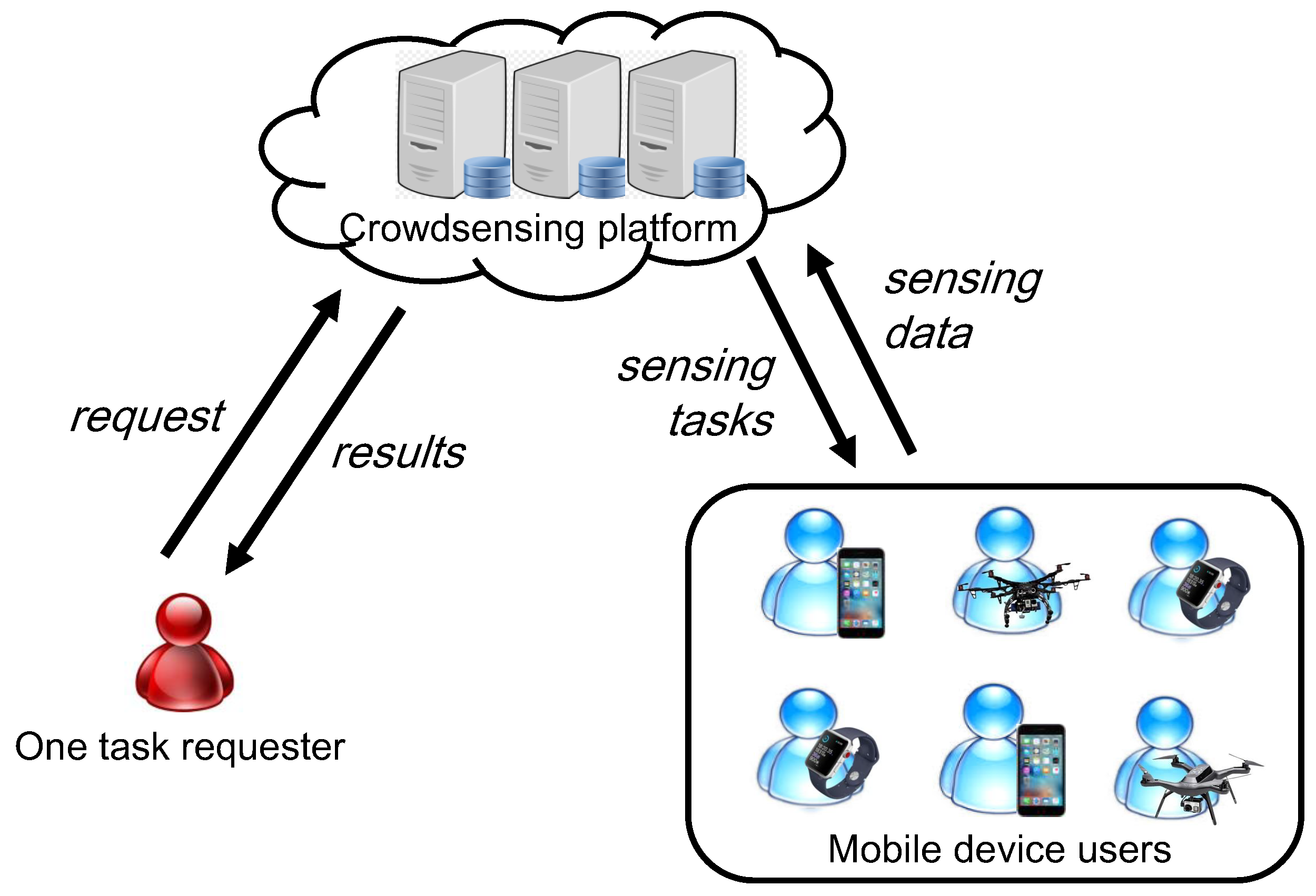
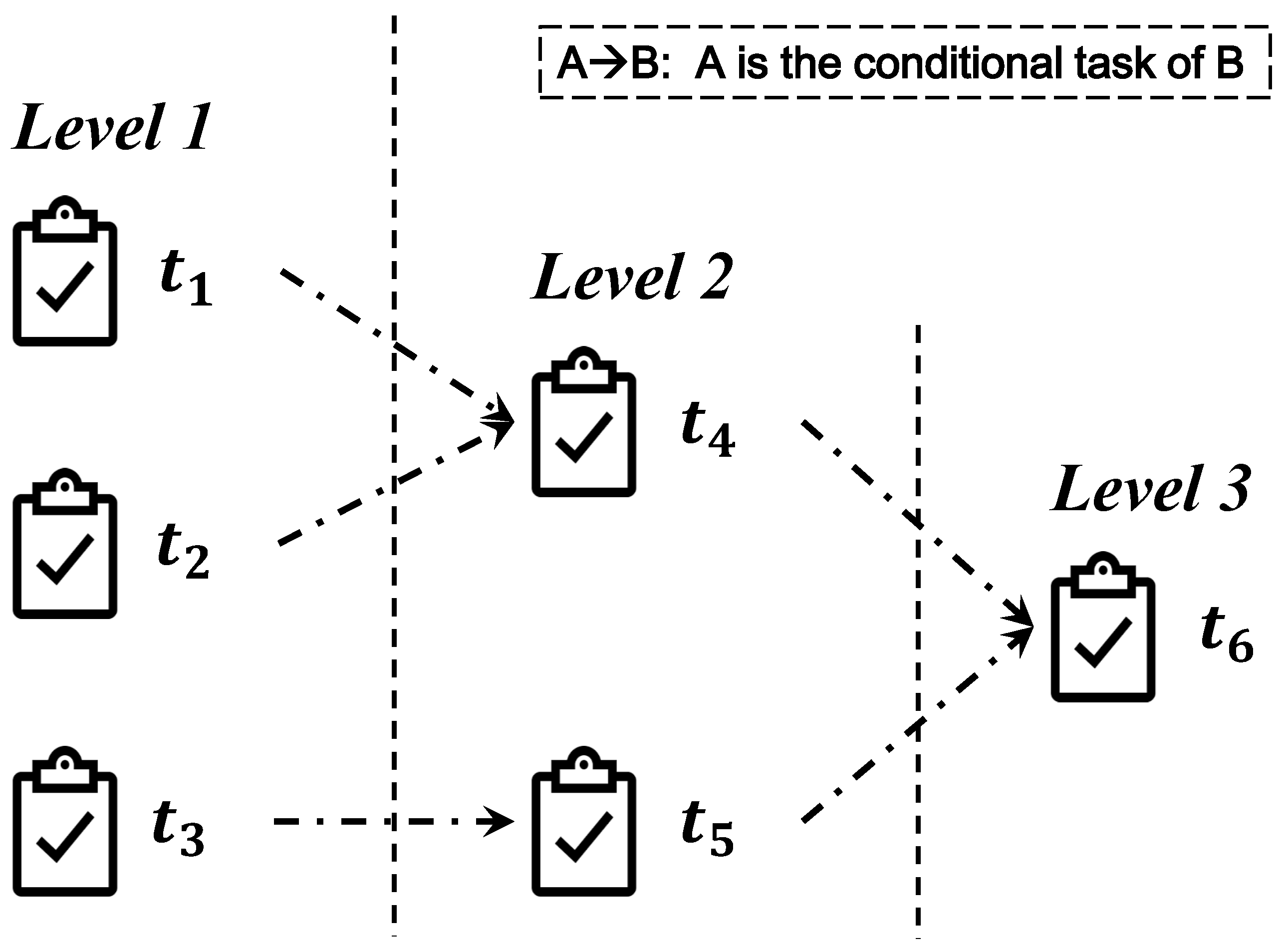




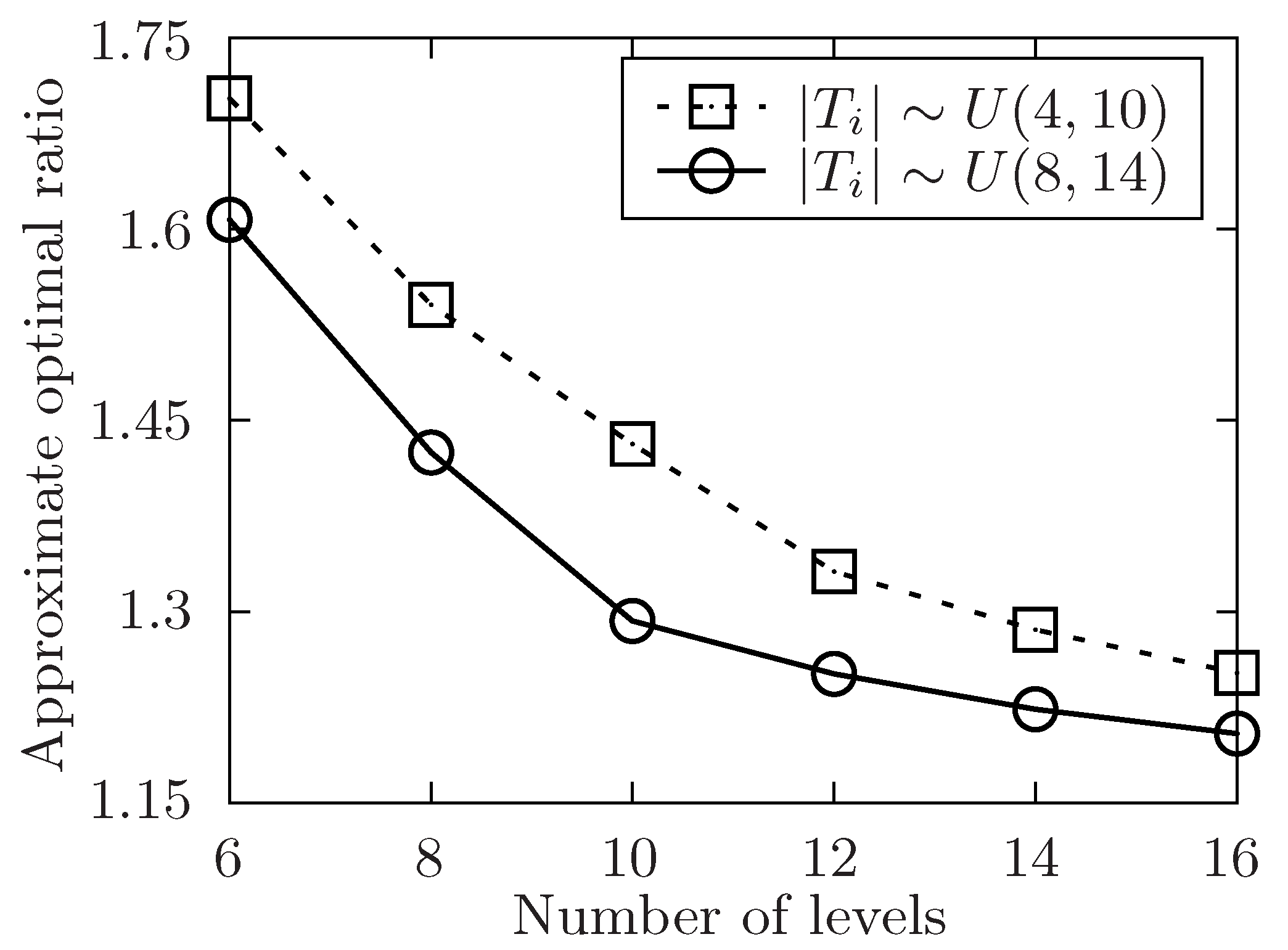

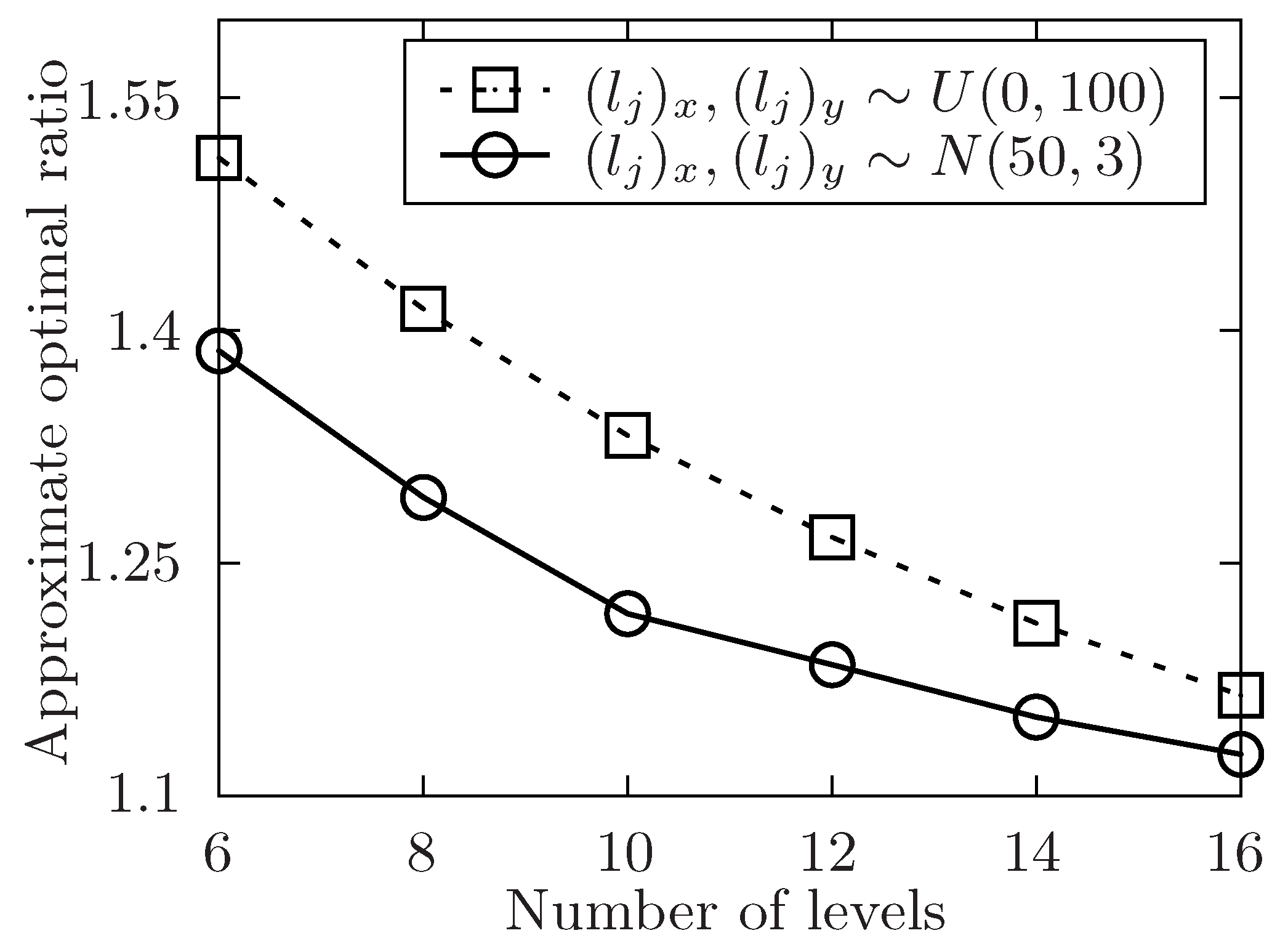

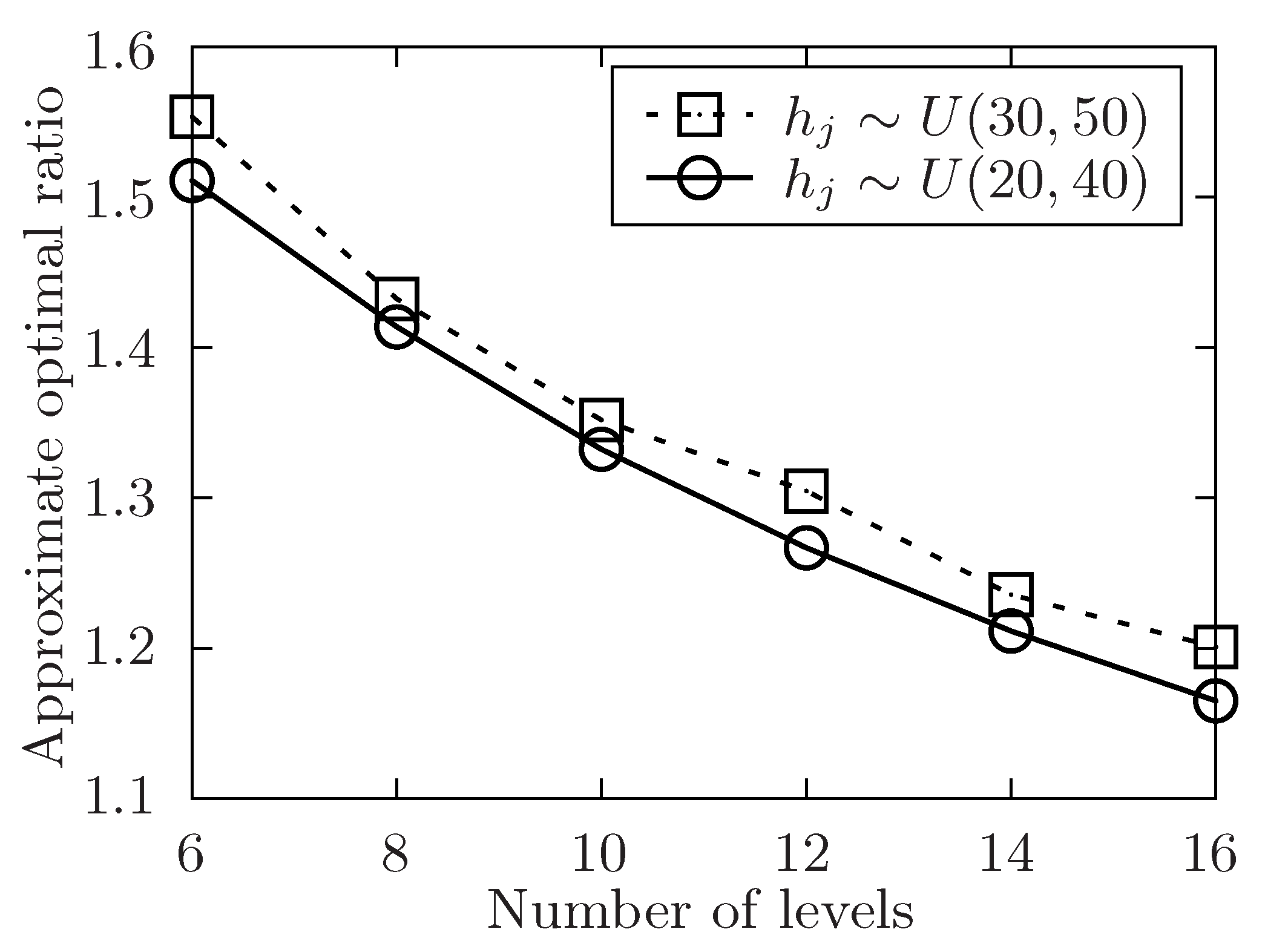
| Notation | Description |
|---|---|
| a set of mobile device users | |
| a mobile device user i | |
| interested tasks submitted by user i | |
| the expected execution time set of user i | |
| the expected execution time of user i for performing task j | |
| the task set submitted by requester | |
| a task j | |
| the conditional task set of task j | |
| the expected performing time of task j | |
| the location of task j | |
| the description of task j | |
| the travel duration of user i to the location of task k | |
| binary variable to represent whether task j is finished | |
| binary variable to represent if task j is permitted to be allocated | |
| binary variable to represent whether task j is allocated to user i | |
| the earliest time that the platform can allocate the task j to a user | |
| the level of task j | |
| the final task set | |
| the order of task j in allocation priority sequence | |
| the expected finishing time of task j | |
| the recorded task with maximum expected finishing time in |
| Case | Description | Fixed Parameter | |||
|---|---|---|---|---|---|
| m | and | ||||
| A | 200 | or | |||
| B | 300 | ||||
| C | 400 | ||||
| D | 400 | ||||
| E | 300 | ||||
| F | 300 | ||||
| Approximate Optimal Ratios | |||||||||||||
|---|---|---|---|---|---|---|---|---|---|---|---|---|---|
| Case | Number of Mobile Device Users () | Number of Levels () | |||||||||||
| 50 | 60 | 70 | 80 | 90 | 100 | 110 | 6 | 8 | 10 | 12 | 14 | 16 | |
| A | 1.413 | 1.316 | 1.236 | 1.209 | 1.183 | 1.163 | 1.117 | 1.234 | 1.160 | 1.133 | 1.116 | 1.094 | 1.084 |
| B | 1.679 | 1.521 | 1.500 | 1.387 | 1.362 | 1.292 | 1.234 | 1.511 | 1.414 | 1.332 | 1.267 | 1.211 | 1.165 |
| C | 1.999 | 1.801 | 1.708 | 1.610 | 1.503 | 1.429 | 1.357 | 1.702 | 1.541 | 1.431 | 1.331 | 1.286 | 1.252 |
| D | 1.802 | 1.715 | 1.529 | 1.455 | 1.344 | 1.293 | 1.249 | 1.607 | 1.425 | 1.293 | 1.251 | 1.223 | 1.204 |
| E | 1.743 | 1.620 | 1.520 | 1.453 | 1.381 | 1.308 | 1.246 | 1.553 | 1.432 | 1.352 | 1.305 | 1.235 | 1.201 |
| F | 1.586 | 1.462 | 1.380 | 1.351 | 1.262 | 1.238 | 1.172 | 1.387 | 1.292 | 1.217 | 1.185 | 1.151 | 1.127 |
© 2019 by the authors. Licensee MDPI, Basel, Switzerland. This article is an open access article distributed under the terms and conditions of the Creative Commons Attribution (CC BY) license (http://creativecommons.org/licenses/by/4.0/).
Share and Cite
Wu, X.; Sun, Y.-E.; Huang, H.; Du, Y.; Huang, D. Time-Efficient Allocation Mechanisms for Crowdsensing Tasks with Precedence Constraints. Sensors 2019, 19, 2456. https://doi.org/10.3390/s19112456
Wu X, Sun Y-E, Huang H, Du Y, Huang D. Time-Efficient Allocation Mechanisms for Crowdsensing Tasks with Precedence Constraints. Sensors. 2019; 19(11):2456. https://doi.org/10.3390/s19112456
Chicago/Turabian StyleWu, Xiaocan, Yu-E Sun, He Huang, Yang Du, and Danlei Huang. 2019. "Time-Efficient Allocation Mechanisms for Crowdsensing Tasks with Precedence Constraints" Sensors 19, no. 11: 2456. https://doi.org/10.3390/s19112456
APA StyleWu, X., Sun, Y.-E., Huang, H., Du, Y., & Huang, D. (2019). Time-Efficient Allocation Mechanisms for Crowdsensing Tasks with Precedence Constraints. Sensors, 19(11), 2456. https://doi.org/10.3390/s19112456





